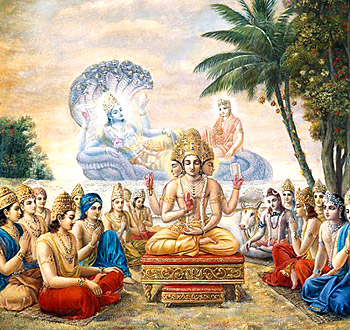 Guru Parampara in Vaishnavism constitutes one of its most important elements. The beliefs of Vaishnavism hold that the Supreme Lord, Narayana, is the first and foremost among all the deities. He is said to be the Guru of the entire world, but he himself does not have a preceptor. Tradition has it that he taught the Vedas to Chaturmukha Brahma and the latter in turn taught it to his sons as well as to others. He disseminated Vedic knowledge through the great sages such as Narada, Parasara, Saunaka. He incarnated Himself as Matsya, Hayagriva, Nara, Narayana and Krishna and revealed the philosophic knowledge. It was by His grace that Vyasa promulgated the great epic, the Mahabharata and the Vedanta Sutra.
Guru Parampara in Vaishnavism constitutes one of its most important elements. The beliefs of Vaishnavism hold that the Supreme Lord, Narayana, is the first and foremost among all the deities. He is said to be the Guru of the entire world, but he himself does not have a preceptor. Tradition has it that he taught the Vedas to Chaturmukha Brahma and the latter in turn taught it to his sons as well as to others. He disseminated Vedic knowledge through the great sages such as Narada, Parasara, Saunaka. He incarnated Himself as Matsya, Hayagriva, Nara, Narayana and Krishna and revealed the philosophic knowledge. It was by His grace that Vyasa promulgated the great epic, the Mahabharata and the Vedanta Sutra.
The place of an Acharya in the Vaishnava religion has been accorded great importance. It is a universal practice common to all religions to show respect to the teacher by a disciple. But the special feature of Vaishnavism is the emphasis it places on worshipping not merely one`s own acharya but the entire lineage of ahcaryas (acharya santati) right up to God who is the first acharya (prathama guru) from whom the spiritual knowledge emanates. There is a tanian or a single stanza pertaining to every preceptor. This is generally composed in Sanskrit language by the first disciple of the preceptor. According to the Vaishnava tradition the tanian of one`s own acharya and also those of his spiritual predecessors right up to Paramatman are to be recited by a Vaishnava both at the time of initiation into Vaishnavism by the prescribed sacraments (pancha samskara) and also at the time of undertaking Vedanta study. Such recitation of tanians at the time of religious acts signifies the importance of worship of the spiritual preceptors and also the acknowledgement of gratitude that a Vaishnava owes to the great service rendered by them to the community by way of preserving and disseminating the sacred knowledge through which alone one can hope to attain salvation.
Vaishnavism claims a long lineage of acharyas commencing from the Supreme Being right up to the guru of an individual. An orthodox Vaishnava who is seeking spiritual knowledge should pay homage to the long succession of acharyas starting from his own right up to the Paramatman. This practice is not a mere convention but on the other hand, it is enjoined on the authority of scripture. Leaving out the divine beings, the principal acharyas who have been included in the spiritual lineage as commonly accepted by the Sri Vaishnavas of both sects are: Nammalvar, also known as Sadagopan (one of the twelve Alvars), Nathamuni, Alavandar, Ramanuja, Vedanta Desika (according to the Vadakalai sect) and Manavalamamuni (according to the Tenkalai sect).
In between Ramanuja and Vedanta Desika the important spiritual descendants are: Pillan, Vishnucitta, Varadacarya also known as Nadadur Ammal, Appullar and then Vedanta Desika (A.D. 1268-1369). The spiritual lineage acknowledged by the followers of Manavalamamuni includes: Embar, Parasara Bhattar, Nanjiyar, Nampillai, Vadakkuttiruvidipillai, Periya Vaccanpillai, Pillai Lokacharya, Srisailesa and Manavalamamuni. Both Vedanta Desika and Manavalamamuni have had a long line of spiritual successors. The biographical accounts of these acharyas are contained in the guruparamparas or the genealogy of preceptors maintained by the concerned religious institutions and the individual families.









